最短路径
这里基于的是加权有向图的讨论,而且是单源最短路径问题。我们称为最短路径的结果是一棵最短路径树。
给定一幅加权有向图和一个顶点s,以s为起点的一棵最短路径树是图的一幅子图,它包含s和从s可达的所有顶点。这棵有向树的根节点为s,树的每条路径(到每个点的每条路径)都是有向图中的一条最短路径。
加权有向图的数据结构
有向边类:
public class EdgeWeightedDigraph {
private static final String NEWLINE = System.getProperty("line.separator");
private final int V; // number of vertices in this digraph
private int E; // number of edges in this digraph
private Bag<DirectedEdge>[] adj; // adj[v] = adjacency list for vertex v
private int[] indegree; // indegree[v] = indegree of vertex v
public EdgeWeightedDigraph(int V) {
if (V < 0) throw new IllegalArgumentException("Number of vertices in a Digraph must be nonnegative");
this.V = V;
this.E = 0;
this.indegree = new int[V];
adj = (Bag<DirectedEdge>[]) new Bag[V];
for (int v = 0; v < V; v++)
adj[v] = new Bag<DirectedEdge>();
}
public EdgeWeightedDigraph(int V, int E) {
this(V);
if (E < 0) throw new IllegalArgumentException("Number of edges in a Digraph must be nonnegative");
for (int i = 0; i < E; i++) {
int v = StdRandom.uniform(V);
int w = StdRandom.uniform(V);
double weight = .01 * StdRandom.uniform(100);
DirectedEdge e = new DirectedEdge(v, w, weight);
addEdge(e);
}
}
public EdgeWeightedDigraph(In in) {
this(in.readInt());
int E = in.readInt();
if (E < 0) throw new IllegalArgumentException("Number of edges must be nonnegative");
for (int i = 0; i < E; i++) {
int v = in.readInt();
int w = in.readInt();
if (v < 0 || v >= V) throw new IndexOutOfBoundsException("vertex " + v + " is not between 0 and " + (V-1));
if (w < 0 || w >= V) throw new IndexOutOfBoundsException("vertex " + w + " is not between 0 and " + (V-1));
double weight = in.readDouble();
addEdge(new DirectedEdge(v, w, weight));
}
}
public EdgeWeightedDigraph(EdgeWeightedDigraph G) {
this(G.V());
this.E = G.E();
for (int v = 0; v < G.V(); v++)
this.indegree[v] = G.indegree(v);
for (int v = 0; v < G.V(); v++) {
// reverse so that adjacency list is in same order as original
Stack<DirectedEdge> reverse = new Stack<DirectedEdge>();
for (DirectedEdge e : G.adj[v]) {
reverse.push(e);
}
for (DirectedEdge e : reverse) {
adj[v].add(e);
}
}
}
public int V() {
return V;
}
public int E() {
return E;
}
// throw an IndexOutOfBoundsException unless 0 <= v < V
private void validateVertex(int v) {
if (v < 0 || v >= V)
throw new IndexOutOfBoundsException("vertex " + v + " is not between 0 and " + (V-1));
}
public void addEdge(DirectedEdge e) {
int v = e.from();
int w = e.to();
validateVertex(v);
validateVertex(w);
adj[v].add(e);
indegree[w]++;
E++;
}
public Iterable<DirectedEdge> adj(int v) {
validateVertex(v);
return adj[v];
}
public int outdegree(int v) {
validateVertex(v);
return adj[v].size();
}
public int indegree(int v) {
validateVertex(v);
return indegree[v];
}
public Iterable<DirectedEdge> edges() {
Bag<DirectedEdge> list = new Bag<DirectedEdge>();
for (int v = 0; v < V; v++) {
for (DirectedEdge e : adj(v)) {
list.add(e);
}
}
return list;
}
public String toString() {
StringBuilder s = new StringBuilder();
s.append(V + " " + E + NEWLINE);
for (int v = 0; v < V; v++) {
s.append(v + ": ");
for (DirectedEdge e : adj[v]) {
s.append(e + " ");
}
s.append(NEWLINE);
}
return s.toString();
}
}Dijstra算法(有向,无负边)
要求权重非负,算法很简单,不再赘述
复杂度: 空间与V成正比,时间与ElogV成正比
内部使用了索引优先队列
public class DijkstraSP {
private double[] distTo; // distTo[v] = distance of shortest s->v path
private DirectedEdge[] edgeTo; // edgeTo[v] = last edge on shortest s->v path
private IndexMinPQ<Double> pq; // priority queue of vertices
public DijkstraSP(EdgeWeightedDigraph G, int s) {
for (DirectedEdge e : G.edges()) {
if (e.weight() < 0)
throw new IllegalArgumentException("edge " + e + " has negative weight");
}
distTo = new double[G.V()];
edgeTo = new DirectedEdge[G.V()];
for (int v = 0; v < G.V(); v++)
distTo[v] = Double.POSITIVE_INFINITY;
distTo[s] = 0.0;
// relax vertices in order of distance from s
pq = new IndexMinPQ<Double>(G.V());
pq.insert(s, distTo[s]);
while (!pq.isEmpty()) {
int v = pq.delMin();
for (DirectedEdge e : G.adj(v))
relax(e);
}
// check optimality conditions
assert check(G, s);
}
// relax edge e and update pq if changed
private void relax(DirectedEdge e) {
int v = e.from(), w = e.to();
if (distTo[w] > distTo[v] + e.weight()) {
distTo[w] = distTo[v] + e.weight();
edgeTo[w] = e;
if (pq.contains(w)) pq.decreaseKey(w, distTo[w]);
else pq.insert(w, distTo[w]);
}
}
public double distTo(int v) {
return distTo[v];
}
public boolean hasPathTo(int v) {
return distTo[v] < Double.POSITIVE_INFINITY;
}
public Iterable<DirectedEdge> pathTo(int v) {
if (!hasPathTo(v)) return null;
Stack<DirectedEdge> path = new Stack<DirectedEdge>();
for (DirectedEdge e = edgeTo[v]; e != null; e = edgeTo[e.from()]) {
path.push(e);
}
return path;
}
// check optimality conditions:
// (i) for all edges e: distTo[e.to()] <= distTo[e.from()] + e.weight()
// (ii) for all edge e on the SPT: distTo[e.to()] == distTo[e.from()] + e.weight()
private boolean check(EdgeWeightedDigraph G, int s) {
// check that edge weights are nonnegative
for (DirectedEdge e : G.edges()) {
if (e.weight() < 0) {
System.err.println("negative edge weight detected");
return false;
}
}
// check that distTo[v] and edgeTo[v] are consistent
if (distTo[s] != 0.0 || edgeTo[s] != null) {
System.err.println("distTo[s] and edgeTo[s] inconsistent");
return false;
}
for (int v = 0; v < G.V(); v++) {
if (v == s) continue;
if (edgeTo[v] == null && distTo[v] != Double.POSITIVE_INFINITY) {
System.err.println("distTo[] and edgeTo[] inconsistent");
return false;
}
}
// check that all edges e = v->w satisfy distTo[w] <= distTo[v] + e.weight()
for (int v = 0; v < G.V(); v++) {
for (DirectedEdge e : G.adj(v)) {
int w = e.to();
if (distTo[v] + e.weight() < distTo[w]) {
System.err.println("edge " + e + " not relaxed");
return false;
}
}
}
// check that all edges e = v->w on SPT satisfy distTo[w] == distTo[v] + e.weight()
for (int w = 0; w < G.V(); w++) {
if (edgeTo[w] == null) continue;
DirectedEdge e = edgeTo[w];
int v = e.from();
if (w != e.to()) return false;
if (distTo[v] + e.weight() != distTo[w]) {
System.err.println("edge " + e + " on shortest path not tight");
return false;
}
}
return true;
}
}无环加权有向图中的最短路径算法
无环,能有负边,比Dijstra算法快
按照拓扑排序(详见之前博客)更新权值
按照拓扑排序更新权值,就能在和E+V成正比的时间内解决无环加权有向图的电源最短路径问题
public class AcyclicSP {
private double[] distTo; // distTo[v] = distance of shortest s->v path
private DirectedEdge[] edgeTo; // edgeTo[v] = last edge on shortest s->v path
public AcyclicSP(EdgeWeightedDigraph G, int s) {
distTo = new double[G.V()];
edgeTo = new DirectedEdge[G.V()];
for (int v = 0; v < G.V(); v++)
distTo[v] = Double.POSITIVE_INFINITY;
distTo[s] = 0.0;
// visit vertices in toplogical order
Topological topological = new Topological(G);
if (!topological.hasOrder())
throw new IllegalArgumentException("Digraph is not acyclic.");
for (int v : topological.order()) {
for (DirectedEdge e : G.adj(v))
relax(e);
}
}
// relax edge e
private void relax(DirectedEdge e) {
int v = e.from(), w = e.to();
if (distTo[w] > distTo[v] + e.weight()) {
distTo[w] = distTo[v] + e.weight();
edgeTo[w] = e;
}
}
public double distTo(int v) {
return distTo[v];
}
public boolean hasPathTo(int v) {
return distTo[v] < Double.POSITIVE_INFINITY;
}
public Iterable<DirectedEdge> pathTo(int v) {
if (!hasPathTo(v)) return null;
Stack<DirectedEdge> path = new Stack<DirectedEdge>();
for (DirectedEdge e = edgeTo[v]; e != null; e = edgeTo[e.from()]) {
path.push(e);
}
return path;
}
}无环加权有向图中的最长路径算法
放松边的那个符号反过来就行了,初始化要改成负无穷
public class AcyclicLP {
private double[] distTo; // distTo[v] = distance of longest s->v path
private DirectedEdge[] edgeTo; // edgeTo[v] = last edge on longest s->v path
public AcyclicLP(EdgeWeightedDigraph G, int s) {
distTo = new double[G.V()];
edgeTo = new DirectedEdge[G.V()];
for (int v = 0; v < G.V(); v++)
distTo[v] = Double.NEGATIVE_INFINITY;
distTo[s] = 0.0;
// relax vertices in toplogical order
Topological topological = new Topological(G);
if (!topological.hasOrder())
throw new IllegalArgumentException("Digraph is not acyclic.");
for (int v : topological.order()) {
for (DirectedEdge e : G.adj(v))
relax(e);
}
}
// relax edge e, but update if you find a *longer* path
private void relax(DirectedEdge e) {
int v = e.from(), w = e.to();
if (distTo[w] < distTo[v] + e.weight()) {
distTo[w] = distTo[v] + e.weight();
edgeTo[w] = e;
}
}
public double distTo(int v) {
return distTo[v];
}
public boolean hasPathTo(int v) {
return distTo[v] > Double.NEGATIVE_INFINITY;
}
public Iterable<DirectedEdge> pathTo(int v) {
if (!hasPathTo(v)) return null;
Stack<DirectedEdge> path = new Stack<DirectedEdge>();
for (DirectedEdge e = edgeTo[v]; e != null; e = edgeTo[e.from()]) {
path.push(e);
}
return path;
}
}一个应用:平行任务调度
优先级限制下的平行任务调度
任务有优先级关系,有些任务必须在其他任务之前完成,单CPU的任务调度其实就是求拓扑排序就行了。平行任务调度则是多个CPU执行,完成时间最短的调度为最优。
平行任务调度相当于求一个最长路径(求“最长路径”是指求优先级限制图的最长路径,比这个更短的路径是满足不了优先级限制的,所以要求最长。而且最长的都能跑,并行的其他短的肯定也能跑),这个图的构造如下:


public class CPM {
// this class cannot be instantiated
private CPM() { }
public static void main(String[] args) {
// number of jobs
int N = StdIn.readInt();
// source and sink
int source = 2*N;
int sink = 2*N + 1;
// build network
EdgeWeightedDigraph G = new EdgeWeightedDigraph(2*N + 2);
for (int i = 0; i < N; i++) {
double duration = StdIn.readDouble();
G.addEdge(new DirectedEdge(source, i, 0.0));
G.addEdge(new DirectedEdge(i+N, sink, 0.0));
G.addEdge(new DirectedEdge(i, i+N, duration));
// precedence constraints
int M = StdIn.readInt();
for (int j = 0; j < M; j++) {
int precedent = StdIn.readInt();
G.addEdge(new DirectedEdge(N+i, precedent, 0.0));
}
}
// compute longest path
AcyclicLP lp = new AcyclicLP(G, source);
// print results
StdOut.println(" job start finish");
StdOut.println("--------------------");
for (int i = 0; i < N; i++) {
StdOut.printf("%4d %7.1f %7.1f\n", i, lp.distTo(i), lp.distTo(i+N));
}
StdOut.printf("Finish time: %7.1f\n", lp.distTo(sink));
}
}相对最后期限下的并行任务调度
再加一个限制:deadline,也就是截止时间限制(相对某个任务的截止时间,比如不能相差多少秒)。方法是同上面一样构造图,同时会添加负权重边,再将所有边取反,然后求最短路径,最短路径存在则可行(没有负权重环就是可行的调度)。
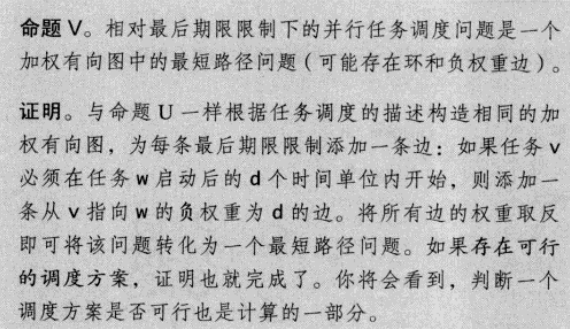
一般有向加权图的最短路径问题
考虑有环也可能负边的最短路径问题

负权重环会导致绕圈现象,因此负权重环存在求不出最短路径

解决路径没有负权重环的最短路径算法:Bellman-ford算法
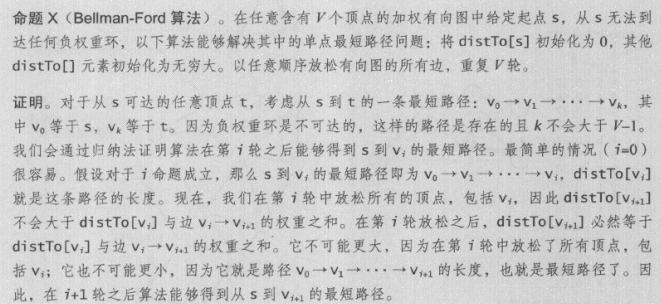

过程:

下面讨论改进版本:
基于队列的Bellman-Ford算法
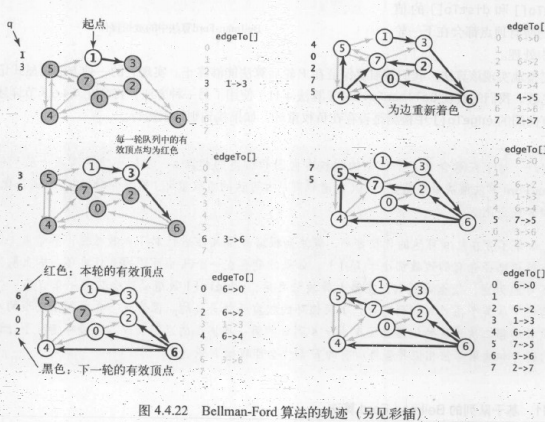
public class BellmanFordSP {
private double[] distTo; // distTo[v] = distance of shortest s->v path
private DirectedEdge[] edgeTo; // edgeTo[v] = last edge on shortest s->v path
private boolean[] onQueue; // onQueue[v] = is v currently on the queue?
private Queue<Integer> queue; // queue of vertices to relax
private int cost; // number of calls to relax()
private Iterable<DirectedEdge> cycle; // negative cycle (or null if no such cycle)
public BellmanFordSP(EdgeWeightedDigraph G, int s) {
distTo = new double[G.V()];
edgeTo = new DirectedEdge[G.V()];
onQueue = new boolean[G.V()];
for (int v = 0; v < G.V(); v++)
distTo[v] = Double.POSITIVE_INFINITY;
distTo[s] = 0.0;
// Bellman-Ford algorithm
queue = new Queue<Integer>();
queue.enqueue(s);
onQueue[s] = true;
while (!queue.isEmpty() && !hasNegativeCycle()) {
int v = queue.dequeue();
onQueue[v] = false;
relax(G, v);
}
assert check(G, s);
}
// relax vertex v and put other endpoints on queue if changed
private void relax(EdgeWeightedDigraph G, int v) {
for (DirectedEdge e : G.adj(v)) {
int w = e.to();
if (distTo[w] > distTo[v] + e.weight()) {
distTo[w] = distTo[v] + e.weight();
edgeTo[w] = e;
if (!onQueue[w]) {
queue.enqueue(w);
onQueue[w] = true;
}
}
if (cost++ % G.V() == 0) {
findNegativeCycle();
if (hasNegativeCycle()) return; // found a negative cycle
}
}
}
public boolean hasNegativeCycle() {
return cycle != null;
}
public Iterable<DirectedEdge> negativeCycle() {
return cycle;
}
// by finding a cycle in predecessor graph
private void findNegativeCycle() {
int V = edgeTo.length;
EdgeWeightedDigraph spt = new EdgeWeightedDigraph(V);
for (int v = 0; v < V; v++)
if (edgeTo[v] != null)
spt.addEdge(edgeTo[v]);
EdgeWeightedDirectedCycle finder = new EdgeWeightedDirectedCycle(spt);
cycle = finder.cycle();
}
public double distTo(int v) {
if (hasNegativeCycle())
throw new UnsupportedOperationException("Negative cost cycle exists");
return distTo[v];
}
public boolean hasPathTo(int v) {
return distTo[v] < Double.POSITIVE_INFINITY;
}
public Iterable<DirectedEdge> pathTo(int v) {
if (hasNegativeCycle())
throw new UnsupportedOperationException("Negative cost cycle exists");
if (!hasPathTo(v)) return null;
Stack<DirectedEdge> path = new Stack<DirectedEdge>();
for (DirectedEdge e = edgeTo[v]; e != null; e = edgeTo[e.from()]) {
path.push(e);
}
return path;
}
// check optimality conditions: either
// (i) there exists a negative cycle reacheable from s
// or
// (ii) for all edges e = v->w: distTo[w] <= distTo[v] + e.weight()
// (ii') for all edges e = v->w on the SPT: distTo[w] == distTo[v] + e.weight()
private boolean check(EdgeWeightedDigraph G, int s) {
// has a negative cycle
if (hasNegativeCycle()) {
double weight = 0.0;
for (DirectedEdge e : negativeCycle()) {
weight += e.weight();
}
if (weight >= 0.0) {
System.err.println("error: weight of negative cycle = " + weight);
return false;
}
}
// no negative cycle reachable from source
else {
// check that distTo[v] and edgeTo[v] are consistent
if (distTo[s] != 0.0 || edgeTo[s] != null) {
System.err.println("distanceTo[s] and edgeTo[s] inconsistent");
return false;
}
for (int v = 0; v < G.V(); v++) {
if (v == s) continue;
if (edgeTo[v] == null && distTo[v] != Double.POSITIVE_INFINITY) {
System.err.println("distTo[] and edgeTo[] inconsistent");
return false;
}
}
// check that all edges e = v->w satisfy distTo[w] <= distTo[v] + e.weight()
for (int v = 0; v < G.V(); v++) {
for (DirectedEdge e : G.adj(v)) {
int w = e.to();
if (distTo[v] + e.weight() < distTo[w]) {
System.err.println("edge " + e + " not relaxed");
return false;
}
}
}
// check that all edges e = v->w on SPT satisfy distTo[w] == distTo[v] + e.weight()
for (int w = 0; w < G.V(); w++) {
if (edgeTo[w] == null) continue;
DirectedEdge e = edgeTo[w];
int v = e.from();
if (w != e.to()) return false;
if (distTo[v] + e.weight() != distTo[w]) {
System.err.println("edge " + e + " on shortest path not tight");
return false;
}
}
}
StdOut.println("Satisfies optimality conditions");
StdOut.println();
return true;
}
}里面有一个EdgeWeightedDirectedCycle 类:
public class EdgeWeightedDirectedCycle {
private boolean[] marked; // marked[v] = has vertex v been marked?
private DirectedEdge[] edgeTo; // edgeTo[v] = previous edge on path to v
private boolean[] onStack; // onStack[v] = is vertex on the stack?
private Stack<DirectedEdge> cycle; // directed cycle (or null if no such cycle)
public EdgeWeightedDirectedCycle(EdgeWeightedDigraph G) {
marked = new boolean[G.V()];
onStack = new boolean[G.V()];
edgeTo = new DirectedEdge[G.V()];
for (int v = 0; v < G.V(); v++)
if (!marked[v]) dfs(G, v);
// check that digraph has a cycle
assert check(G);
}
// check that algorithm computes either the topological order or finds a directed cycle
private void dfs(EdgeWeightedDigraph G, int v) {
onStack[v] = true;
marked[v] = true;
for (DirectedEdge e : G.adj(v)) {
int w = e.to();
// short circuit if directed cycle found
if (cycle != null) return;
//found new vertex, so recur
else if (!marked[w]) {
edgeTo[w] = e;
dfs(G, w);
}
// trace back directed cycle
else if (onStack[w]) {
cycle = new Stack<DirectedEdge>();
while (e.from() != w) {
cycle.push(e);
e = edgeTo[e.from()];
}
cycle.push(e);
return;
}
}
onStack[v] = false;
}
public boolean hasCycle() {
return cycle != null;
}
public Iterable<DirectedEdge> cycle() {
return cycle;
}
// certify that digraph is either acyclic or has a directed cycle
private boolean check(EdgeWeightedDigraph G) {
// edge-weighted digraph is cyclic
if (hasCycle()) {
// verify cycle
DirectedEdge first = null, last = null;
for (DirectedEdge e : cycle()) {
if (first == null) first = e;
if (last != null) {
if (last.to() != e.from()) {
System.err.printf("cycle edges %s and %s not incident\n", last, e);
return false;
}
}
last = e;
}
if (last.to() != first.from()) {
System.err.printf("cycle edges %s and %s not incident\n", last, first);
return false;
}
}
return true;
}
}套汇
一种货币换成另一种货币,然后再换回来(换过去和换回来的中间货币可能不一样)造成了一定利润空间,称为套汇。









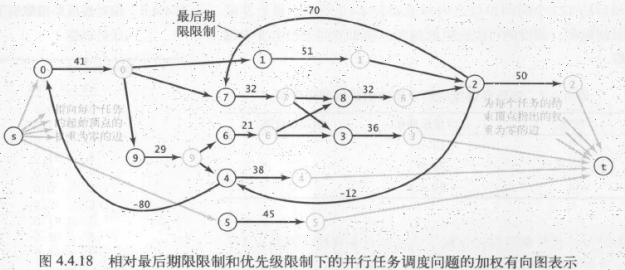
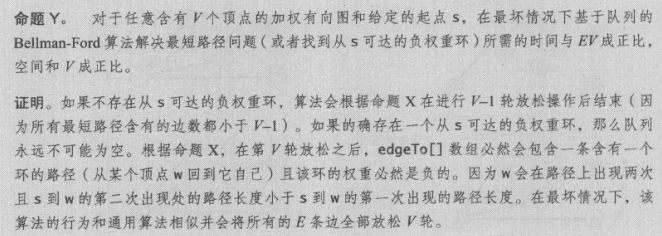















 956
956

 被折叠的 条评论
为什么被折叠?
被折叠的 条评论
为什么被折叠?








